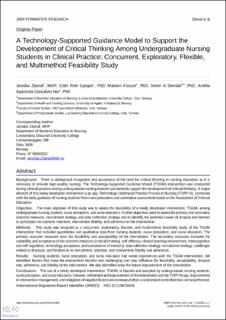| dc.contributor.author | Zlamal, Jaroslav | |
| dc.contributor.author | Gjevjon, Edith Roth | |
| dc.contributor.author | Fossum, Mariann | |
| dc.contributor.author | Steindal, Simen Alexander | |
| dc.contributor.author | Nes, Andrea Aparecida Gonçalves | |
| dc.date.accessioned | 2024-04-12T09:29:34Z | |
| dc.date.available | 2024-04-12T09:29:34Z | |
| dc.date.created | 2023-05-31T09:02:22Z | |
| dc.date.issued | 2023 | |
| dc.identifier.citation | Zlamal, J., Roth Gjevjon, E., Fossum, M., Steindal, S. A. & Nes, A. A. G. (2023). A Technology-Supported Guidance Model to Support the Development of Critical Thinking Among Undergraduate Nursing Students in Clinical Practice : Concurrent, Exploratory, Flexible, and Multimethod Feasibility Study. JMIR Formative Research, 7: e43300. | en_US |
| dc.identifier.issn | 2561-326X | |
| dc.identifier.uri | https://hdl.handle.net/11250/3126248 | |
| dc.description.abstract | Background: There is widespread recognition and acceptance of the need for critical thinking in nursing education, as it is necessary to provide high-quality nursing. The Technology-Supported Guidance Model (TSGM) intervention was conducted during clinical practice among undergraduate nursing students and aimed to support the development of critical thinking. A major element of this newly developed intervention is an app, Technology-Optimized Practice Process in Nursing (TOPP‑N), combined with the daily guidance of nursing students from nurse preceptors and summative assessments based on the Assessment of Clinical Education.
Objective: The main objective of this study was to assess the feasibility of a newly developed intervention, TSGM, among undergraduate nursing students, nurse preceptors, and nurse educators. Further objectives were to assess the primary and secondary outcome measures, recruitment strategy, and data collection strategy and to identify the potential causes of dropout and barriers to participant recruitment, retention, intervention fidelity, and adherence to the intervention.
Methods: This study was designed as a concurrent, exploratory, flexible, and multimethod feasibility study of the TSGM intervention that included quantitative and qualitative data from nursing students, nurse preceptors, and nurse educators. The primary outcome measures were the feasibility and acceptability of the intervention. The secondary outcomes included the suitability and acceptance of the outcome measures (critical thinking, self-efficacy, clinical learning environment, metacognition and self-regulation, technology acceptance, and competence of mentors); data collection strategy; recruitment strategy; challenges related to dropouts; and hindrances to recruitment, retention, and intervention fidelity and adherence.
Results: Nursing students, nurse preceptors, and nurse educators had varied experiences with the TSGM intervention. We identified factors that make the intervention feasible and challenging and may influence the feasibility, acceptability, dropout rate, adherence, and fidelity of the intervention. We also identified areas for future improvement of the intervention.
Conclusions: The use of a newly developed intervention, TSGM, is feasible and accepted by undergraduate nursing students, nurse preceptors, and nurse educators; however, refinement and improvement of the intervention and the TOPP‑N app, improvement in intervention management, and mitigation of negative factors are necessary before a randomized controlled trial can be performed. | en_US |
| dc.language.iso | eng | en_US |
| dc.publisher | JMIR Publications | en_US |
| dc.rights | Navngivelse 4.0 Internasjonal | * |
| dc.rights.uri | http://creativecommons.org/licenses/by/4.0/deed.no | * |
| dc.title | A Technology-Supported Guidance Model to Support the Development of Critical Thinking among Undergraduate Nursing Students in Clinical Practice : Concurrent, Exploratory, Flexible, and Multimethod Feasibility Study | en_US |
| dc.type | Journal article | en_US |
| dc.type | Peer reviewed | en_US |
| dc.description.version | publishedVersion | en_US |
| dc.rights.holder | © 2023 The Author(s) | en_US |
| dc.subject.nsi | VDP::Medisinske Fag: 700::Helsefag: 800::Sykepleievitenskap: 808 | en_US |
| dc.source.pagenumber | 19 | en_US |
| dc.source.volume | 7 | en_US |
| dc.source.journal | JMIR Formative Research | en_US |
| dc.identifier.doi | https://doi.org/10.2196/43300 | |
| dc.identifier.cristin | 2150345 | |
| dc.source.articlenumber | e43300 | en_US |
| cristin.qualitycode | 1 | |

